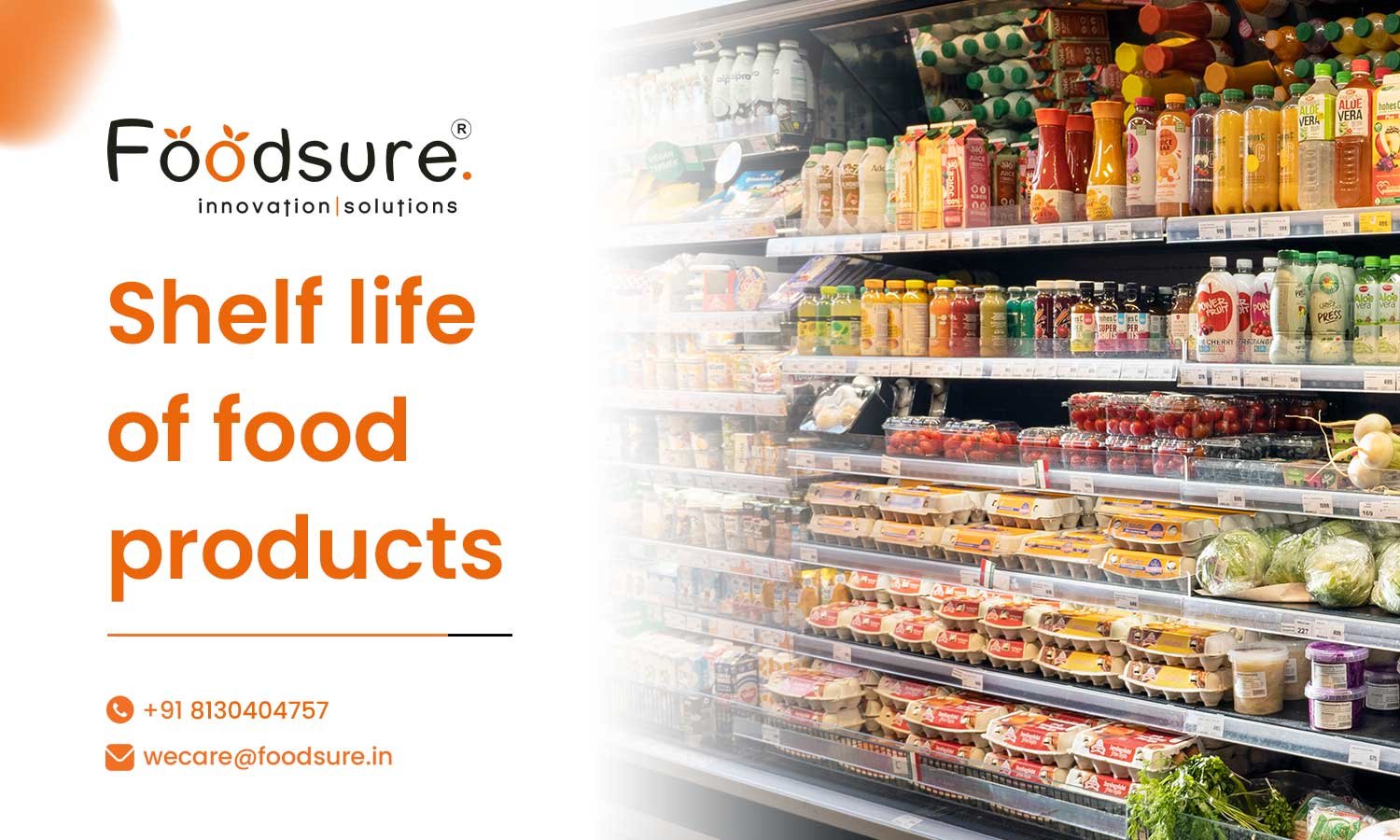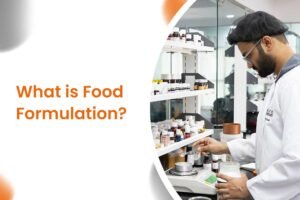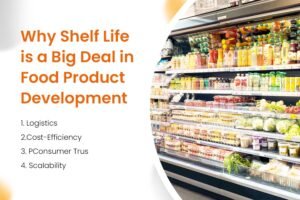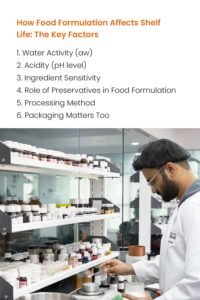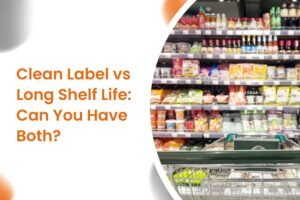Why does one energy bar stay fresh for six months, while another turns stale in just seven days?
It’s not luck. And it’s definitely not just the packaging.
It all starts with one thing: food formulation and shelf life — the behind-the-scenes hero of every successful product.
If you’re dreaming of launching a new food or beverage — or struggling to fix one that isn’t scaling — here’s the truth no one tells you:
The shelf life of food products isn’t decided on store shelves. It’s agreed in your food R&D lab, long before the first batch rolls out.
If you are searching for how to improve the shelf life of products, keep reading this. Every ingredient you choose, every process you follow, every tweak you make — it all adds up. It’s what determines whether your product survives 6 months on a shelf… or crashes within a week. So it is, all about the shelf life of food products.
Your formulation is your foundation.
And it can make or break your brand.
What Is Food Formulation?
We have covered the food formulation topic in depth; give it a read. Let’s take a small briefing. In simple words, food formulation is the art and science of choosing the right ingredients and combining them in the right way to create a food product and a shelf life. But it’s not just about making your food taste good. It’s also about how long it lasts, how safe it is, and how well it travels and stores. It covers everything, including the shelf life of food products.
When you plan your food product’s recipe, you’re also deciding the shelf life of food products, nutritional value, texture, flavor stability, and even packaging compatibility.
Why Shelf Life Is A Big Deal In Food Product Development?
Food formulation and shelf life are more than just a timeline. It affects your entire business:
- Logistics: Longer shelf life gives you more time for storage, transportation, and retail sales.
- Cost-Efficiency: Fewer returns, less spoilage, and better inventory management.
- Consumer Trust: No one likes a product that spoils before it should.
- Scalability: The longer your product stays fresh, the easier it is to scale and distribute across cities or countries.
If you’re serious about building a strong food or beverage brand, shelf life isn’t optional. It’s essential. Connect with the best beverage formulation consultant who can guide you throughout.
How Food Formulation Affects Shelf Life: The Key Factors
1. Water Activity (aw)
Excess moisture is one of the main causes of food spoilage, especially for fresh and high-moisture foods. Moisture creates the perfect environment for mold, bacteria, and other spoilage microbes to grow. And once they show up, the shelf life of food products starts ticking down fast.
That’s why food product stability depends on water activity (which means how much free water is available in your product), which is a critical step in smart food formulation.
So, how can you control water activity?
- Add salt or sugar – both help bind water and keep microbes away
- Use drying techniques – baking, dehydrating, or roasting work well
- Choose shelf-stable ingredients – like dry milk powder, oats, or dried fruits
Example: Ever noticed how protein bars last for months? That’s because they’re made with low-moisture ingredients like nuts and dates. No extra water = no early spoilage.
Controlling water activity = longer shelf life, better products, and happier customers.
2. Acidity (pH level)
Microorganisms dislike acidic environments. Foods with low pH (high acidity) have longer shelf lives.
Common acidifiers:
- Lemon juice
- Vinegar
- Ascorbic acid (Vitamin C)
Example: Aam panna or tomato ketchup naturally has a longer shelf life because of its acidic base.
3. Ingredient Sensitivity
Here’s something most new food brands learn the hard way — not all ingredients have the same shelf life.
Some, like fresh milk, cream, fresh fruits, or raw nuts, are highly perishable. They spoil quickly, especially without proper storage or preservatives. These ingredients are tasty and nutritious, but they also cause bacteria, mold, and rancidity (when fats go bad) if not handled properly.
That’s why choosing the right ingredients during food formulation is super important if you want your product to last longer.
Pro tips:
- Replace dairy with shelf-stable milk powders
- Use pasteurized or treated juices
- Choose stabilized fats or oils to prevent rancidity.
4. Role of Preservatives in Food Formulation
Preservatives are substances added to prevent spoilage. You can go the synthetic or natural route.
- Synthetic: Sodium benzoate, potassium sorbate
- Natural: Rosemary extract, tocopherol (Vitamin E), vinegar, citric acid
Clean-label tip: Use natural preservatives to keep your ingredients list consumer-friendly. This is the role of preservatives in food formulation.
5. Processing Method
How you make your product also affects its shelf life.
Examples of shelf-life-extending methods:
- Pasteurization
- UHT (Ultra High Temperature) treatment
- Dehydration
- High-Pressure Processing (HPP)
- Fermentation
If your formulation doesn’t work with your process, shelf life may drop significantly.
6. Packaging Matters Too
Even the best formulation needs the right packaging. Oxygen exposure, light, and moisture can destroy shelf life.
Choose:
- Vacuum sealing for dry goods
- Light-resistant bottles for juices
- MAP (Modified Atmosphere Packaging) for fresh foods
These are the factors that affect the shelf life of food products. So, you should consider these factors, and this is how to improve the shelf life of products and grow your business.
Clean Label vs Long Shelf Life: Can You Have Both?
Consumers today love clean-label products — no chemicals, no unpronounceable additives, and fewer ingredients. But they also want safety and longer shelf lives.
So how do you balance both?
- Use natural acidifiers and preservatives.
- Experiment with fermentation and probiotics
- Rely on HPP or other non-thermal techniques
- Combine smart formulation with advanced packaging
Pro Tip: Work with formulation consultants who specialize in clean-label product development.
Case Study: A Juice Brand’s Shelf Life Makeover
A startup selling cold-pressed sugarcane juice initially faced huge losses due to spoilage in just 48 hours. With expert help, they:
- Added lemon for natural acidity
- Used fine filtration
- Shifted to HPP tech
- Switched to UV-protected bottles
Result? Shelf life extended to 18 days. The product entered retail stores and e-commerce with confidence.
How To Plan Shelf Life Into Your Food Product
If you’re launching a product, start with shelf life in mind. Here’s how:
- Define your ideal shelf life (7 days? 3 months?)
- Choose ingredients accordingly
- Consider your target market (Urban? Rural? Export?)
- Pick suitable processing methods
- Test your formulation (both real-time and accelerated tests)
- Adapt packaging to match shelf needs
- Consult formulation experts early
Common Killers In Shelf-Life And Food Formulation
- Too much moisture
- Unstable fats
- High sugar without acid balance
- Lack of preservatives (or wrong ones)
- Poor packaging
Avoid these, and you’re already ahead.
Ingredients Known for Better Shelf Life
| Ingredient | Shelf Life Role |
| Citric Acid | Natural preservative & pH controller |
| Apple Cider Vinegar | Flavor + natural acidifier |
| Coconut Sugar | Lower moisture than regular sugar |
| Dehydrated Fruits | Low water activity |
| Tapioca Starch | Acts as a thickener and stabilizer |
Final Thoughts: Smart Formulation Builds Strong Brands
A great shelf life is not just science — it’s a strategy. It saves money, boosts trust, and allows you to expand. But more importantly, it makes your product reliable, which is something every consumer wants.
If you’re serious about food product development, don’t just think about flavor and texture. Think about freshness and the future, too.
Whether you’re making a vegan milk, health bar, sauce, or kombucha — let your formulation do the hard work of keeping it fresh, safe, and scalable.
Need expert help with formulation or shelf-life extension?
Call at +91 8130404757. Let professionals guide your recipe, shelf strategy, and testing plan for maximum success.
FAQs
Q1. What factors affect the shelf life of food products?
Shelf life is affected by formulation, moisture level, pH, preservatives, processing techniques, and packaging quality.
Q2. Why is water activity important in determining shelf life?
Low water activity prevents microbial growth and helps extend shelf life.
Q3. How does pH impact food stability?
Lower pH (more acidic foods) helps inhibit microbes and improves product stability.
Q4. Can natural preservatives extend shelf life?
Yes, natural acidifiers and plant-based preservatives can increase shelf life without synthetic additives.
Q5. What role does packaging play in shelf life?
Packaging protects food from oxygen, moisture, and light—major factors that accelerate spoilage.
Q6. How does food processing influence shelf life?
Techniques like pasteurization, sterilization, and dehydration increase product stability and reduce spoilage.
Q7. What causes rapid spoilage in food products?
High moisture, weak packaging, improper processing, and poor ingredient selection commonly cause spoilage.
Q8. How can brands improve the shelf life of new food products?
By managing water activity, pH, preservatives, processing steps, and stability testing during development.
Q9. Is clean-label shelf life possible?
Yes—using natural preservatives, correct processing, and smart packaging can extend shelf life cleanly.
Q10. Why is shelf-life testing necessary?
It confirms product stability, safety, and quality before large-scale manufacturing.

